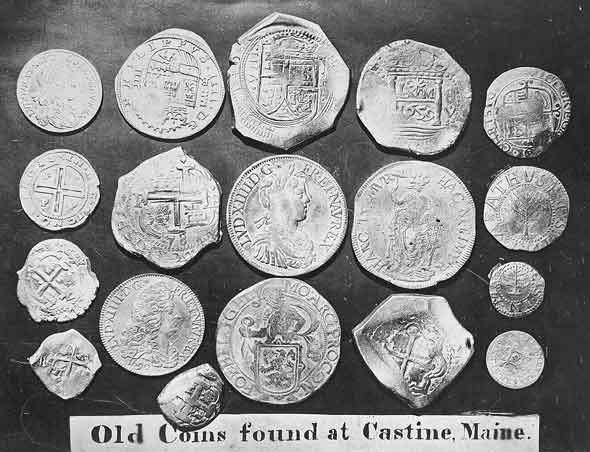Created 1642 to 1688 | ||
 | ||
Material North American colonial coins Size 500 - 2,000 coins (Est.) Present location Castine, Maine, a majority of the coins were dispersed over time. | ||
The Castine Hoard (also known as The Castine Deposit) is the name given to identify a treasure trove of 500 - 2,000 North American colonial coins that were found in Castine, Maine. The coins were from various countries, and were buried sometime in the late 1600s. In the early 1840s the coins were discovered on a farm owned by the Grindle family.
Contents
Origin
The coins were thought to have been a secret stash belonging to Baron Jean-Vincent d'Abbadie de Saint-Castin. Jean Vincent moved from France to the new world becoming a battalion leader, and later a Baron following the death of his father. Jean eventually fell in love with the trading post of Pentagoet, and moved there once his army duties had been complete. While in Pentagoet he became more than friendly with the Indians, eventually becoming a local chief. Jean later married the daughter of another chief, and they had a daughter.
In 1704, British forces led by Major Church stormed and captured the village of Pentagoet. Fearing the British would discover her fathers stash Jean's daughter re-hid, and buried the coins in a safer spot. Within an hour though she was captured, and never returned to take the money for her-self. Baron Jean Vincent who was away on family business died in France a few days after his daughter's capture.
The Hoard
The coins were discovered in 1840 by Captain Stephen Grindle and his son Samuel who unearthed the coins on their farm located near the Bagaduce River. Between 1840 and 1841 hundreds of coins were unearthed, no record exists of a total figure but between 500 and 2,000 were believed to have been found. In 1859, a paper that was originally written by Joseph Williamson was published posthumously in which he describes the coins; "Most of the coins were French crowns, half-crowns, and quarters, all of the reigns of Louis XIII. And Louis XIV., and bore various dates, from 1642 to 1682." The coin hoard was later found to contain coins from Spain, and included a large quantity of Spanish Cobbs. Also found were Pine tree shillings dating from 1652, as well as various coins from other different countries. The earliest coin found was from the reign of King John IV, while the most recent coins dated no later than 1688. The coins were dispersed over time after their discovery, and by 1942 the Maine Historical Society had 26 of the coins remaining. More coins are thought to exist, but none have since been found.
